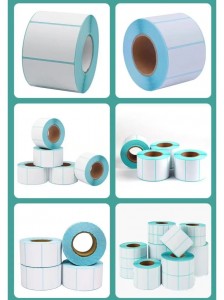In modern warehouse management, efficient inventory and logistics operations directly affect the company’s costs and customer satisfaction. As a simple but powerful tool, self-adhesive labels can significantly improve the accuracy and efficiency of warehouse management. This article will explore how self-adhesive labels can optimize inventory and logistics processes to help companies reduce costs and increase efficiency.
1. Improve information accuracy and reduce human errors
Traditional handwritten labels or vague logos are prone to picking errors, inaccurate inventory data and other problems. Self-adhesive labels can print clear barcodes, QR codes or RFID tags to ensure that the information of each product, shelf or pallet can be quickly scanned and identified. For example, the use of GS1 standard barcodes can avoid wrong shipments and missed shipments caused by human input errors, and improve the reliability of inventory data.
2. Speed up picking and inventory counting
During the peak period of logistics, fast and accurate picking is essential. Self-adhesive labels can be used with PDA (handheld terminal) or AGV (automatic guided vehicle) to achieve automatic scanning and reduce manual search time. For example, e-commerce warehouses can use dual identification of “cargo location label” + “product label” to enable pickers to quickly locate goods, reduce walking time, and improve order processing efficiency. At the same time, scanning labels during inventory can synchronize data in real time to avoid the lag of traditional paper records.
3. Optimize inventory management and batch tracking
Self-adhesive labels can contain key information such as production date, batch number, and expiration date, helping warehouse personnel implement FIFO (first in, first out) strategy and reduce expired waste. In addition, in industries such as medicine and food, the anti-counterfeiting and traceability functions of labels can ensure supply chain compliance. Once problematic products are found, batches can be quickly locked and recalled to reduce corporate risks.
4. Adapt to diverse storage environments
High-quality self-adhesive labels have characteristics such as waterproof, oil-proof, high and low temperature resistance, and are suitable for special scenarios such as cold chain, chemical, and outdoor storage. For example, frozen food warehouses can use low-temperature glue labels to ensure that they are still firmly attached at -20℃ to avoid shedding and information loss.
5. Reduce long-term operating costs
Although the initial investment of self-adhesive labels may be higher than that of handwritten labels, the advantages of improved efficiency, reduced errors, and reduced losses can significantly reduce costs in long-term operations. For example, a US retail company has increased its inventory accuracy to 99.9% and logistics efficiency by more than 30% through the comprehensive application of barcode labels.
Although small, self-adhesive labels are key details in warehouse management. From reducing errors to improving efficiency, from inventory optimization to cost control, its application can bring a qualitative leap to the modern logistics system. Enterprises should choose appropriate label materials, printing technologies and management systems based on their own needs to maximize warehousing and logistics efficiency and gain an advantage in the fierce market competition.
Post time: May-26-2025


